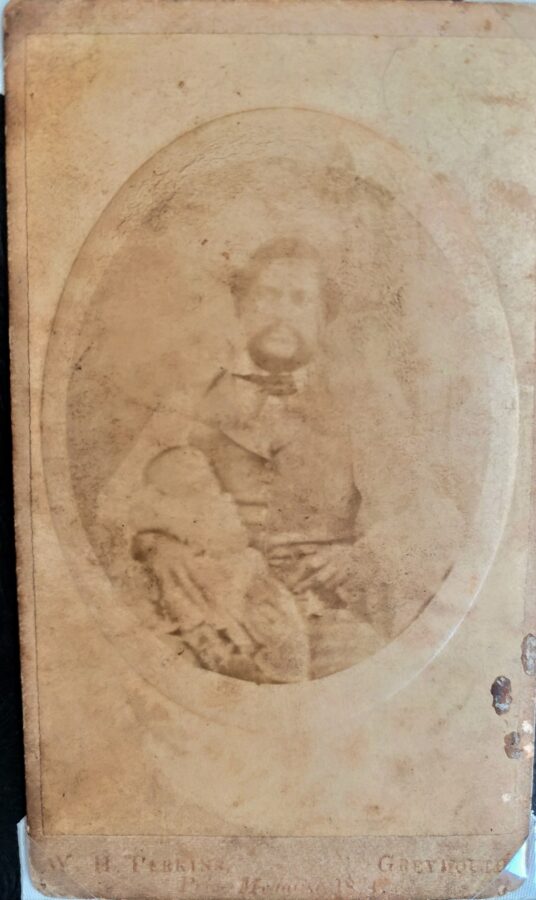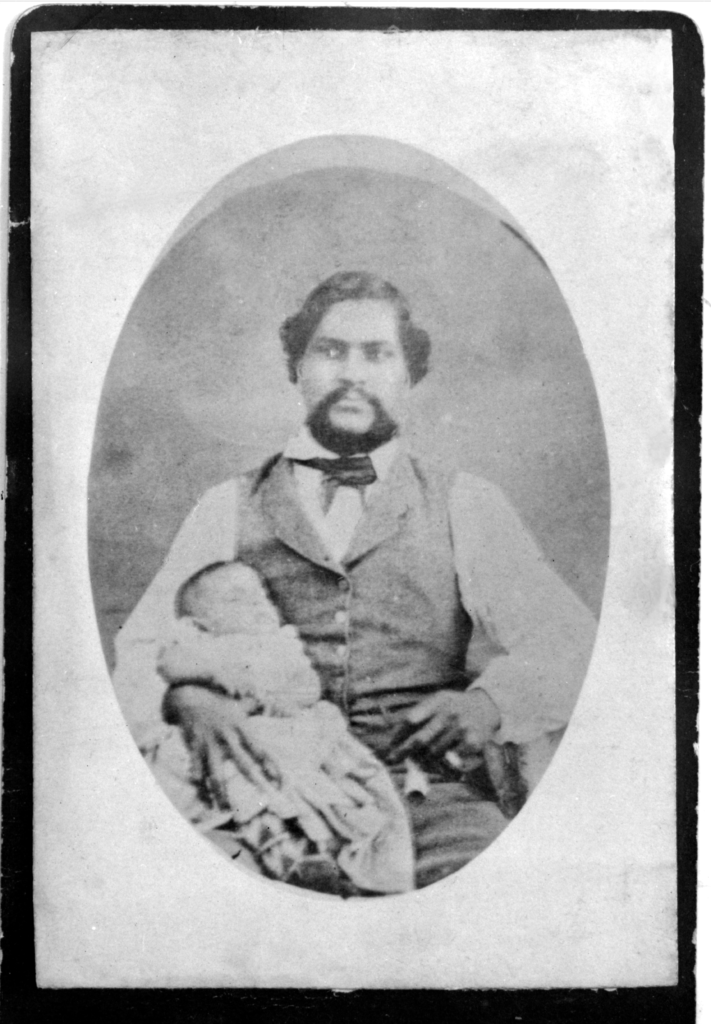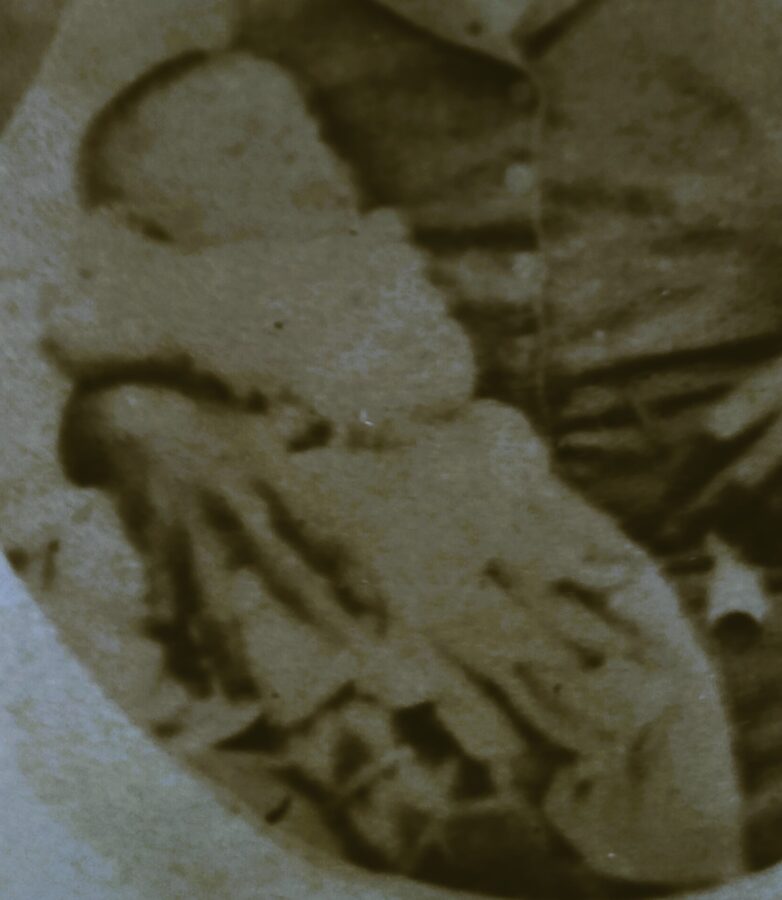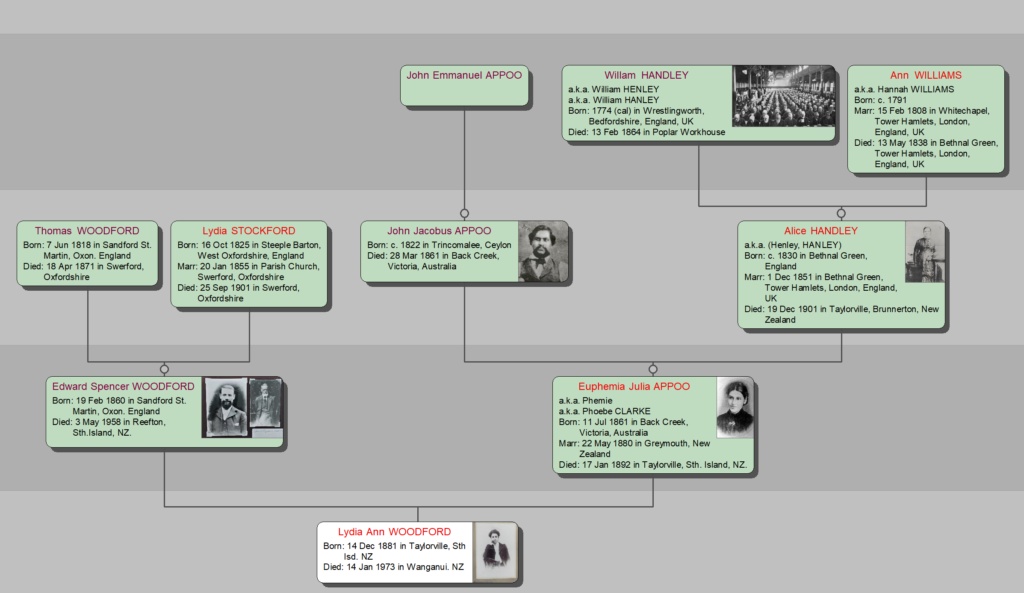Clues to an Ancestor Hidden in a Photograph


A faded, tattered photograph of a man holding a baby is the only known image of John Jacobus Appoo (JJA), my 3X great-grandfather. The original sepia-toned photograph, gifted to my mother by her Great Aunt Ruth, is worn and stained rendering the detail barely decipherable. This image along with a sprinkling of facts gleaned from combing records, is widely shared and frequently displayed by descendants. There did not appear to be evidence that the photograph had been carefully scrutinized. Could it reveal more?
To begin it seemed necessary to acknowledge my own bias. I had always proudly shared this image assuming this was a good man, a kind man, a man devoted to family. A man who supported his family by sailing the spice routes as a ship’s steward, and later an entrepreneur on the Antipodean goldfields. Looking carefully at the image I realised this positive view is unproven and naive. Without evidence how can I know what kind of man he was, and the values he lived by?
While the kind of man he was and how he lived may never be revealed. I needed to be open to discovery, conscious of bias and aware of the desire to have all ancestors as heroes. I was ready to see what this photograph could uncover.
When was the photo taken? Was this Jacobus Appoo? Who was the baby in the photo? Was the baby alive or dead?
A simple first step was to try and date the photograph. Early in 2023 the family history site “My Heritage” introduced an image dating function which I eagerly experimented with. 1875 was the answer for this photograph (give or take 5 years). This was not what I was anticipating. JJA died in 1861.
Researching the photographer whose name was embossed on the carte de visite seemed to corroborate the dating of My Heritage. W.H. Perkins of Greymouth, Aotearoa New Zealand (NZ) was active in Greymouth in the 1870s and 1880s. Well after the death of JJA and with no evidence he had ever been in Greymouth.
This photograph was family folklore, widely published and proudly claimed. For a time, further examination was set aside while I contemplated the impact on my mother and other descendants if this was not JJA. Discussion with fellow family researchers, including my mother, urged continuing whatever the outcome. It was time to find someone who could investigate the photograph in a more skilled way.
My research found Maureen Taylor ‘The Photo Detective’. A simple process from uploading the image and information to completion. After a video call to discuss the findings, a video download and written transcript were provided. The latter has been useful to accurately recall the discussion.
Dating of the Image
The first piece of information I was relieved to hear was that this Carte de visite appeared to be a copy of an earlier picture. Maureen explained that it was likely somebody (in the 1870-80s) had a copy made of an earlier (1850s) photograph. The original could have been an Ambrotype, Daguerreotype, or even a paper photograph. It was a surprise to learn that early in the 19th century it was not unusual to have copies of photographs made. It was also a discovery that Daguerreotypes had been available in NZ and England in the early 1850s, earlier than I had thought.
Maureen questioned who made the copy and when. The answer to both questions is unknown. This is the only original card de visite I have sighted, and any other copies match this image. While JJA was not in Greymouth, his wife Alice and family moved to the West Coast near Greymouth NZ where she lived out her life. It is possible that Alice, her children or grandchildren had the image copied.
The Man

JJA is wearing a loose tie wrapped around his neck and under his collar. Displaying an image from a book on clothing history Maureen mused “He has that same tie and that same vest… that’s the 1850s…”
A faint pattern could be discerned on the pants of JJA. Plaid pants. A man wearing similar plaid pants could be seen in a sketch Maureen displayed on the screen, dating from 1849.
The man held an object in his left hand. A closer examination of the object showed a pipe – the bowl of the pipe sitting on his leg and the stem threading upwards through his fingers.
” Interesting that this man had taken his child to the photo studio, not the mother…It is actually kind of rare to see men holding babies in studios”. “What is the significance…?” The man’s expression captures our attention – the man’s eyes look to the right, away from the camera, with a strange expression on his face. Could it be grief?
As we finish the study of the man I am relieved to hear Maureen muse that it could be JJA.
The Baby

The baby is wearing a long gown commonly worn by all infants. The degraded state of the image limits further discovery. It was noted that the baby was wearing interesting little shoes. A close-up view appears to show calf-length bootees possibly cloth boots or moccasin style with ties wrapping the legs.
Echoing a question I had, Maureen pondered “Is the baby dead or is the baby alive?” Answering her own question – that it was not possible to say. Establishing who the baby could be might provide some answers.
The baby was estimated to be 3 to 6 months old. The likely dating of the original photograph was the early 1850’s. Maureen estimated the baby could be Elizabeth Sylvia born in 1853.
In a rookie research error, at the time I spoke to Maureen, I did not have the timeline with me. Recalling incorrectly that Elizabeth Sylvia died when she was a few days old; discounting that the baby in the photo could be her. Checking facts post-interview, I realised Elizabeth Sylvia was 9 weeks old when she died in October 1853 and therefore possibly the baby in the photo.
The Conclusion
What of Alice and Jacobus Appoo’s other babies? The baby could not be Euphemia Julia (my 2X great-grandmother) as she was not born until after JJA died. It was unlikely the baby was John Bestian who died aged 9 months old in 1860. At this time JJA would likely have been emaciated with Phthisis, this image shows a seemingly healthy man. Two other children were possibilities but unlikely owing to the dating of the image to the early 1850s. Thomas Andrew was born in 1856 and Alice Elizabeth in 1858. It could be possible that fashions in Australia and NZ were behind the European years.
